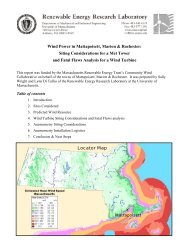Erickson-Indiana-bat
Erickson-Indiana-bat
Erickson-Indiana-bat
You also want an ePaper? Increase the reach of your titles
YUMPU automatically turns print PDFs into web optimized ePapers that Google loves.
250000<br />
No WNS<br />
Low WNS<br />
Mortality<br />
Medium WNS<br />
Mortality<br />
High WNS<br />
Mortality<br />
200000<br />
Population Size<br />
150000<br />
100000<br />
50000<br />
0<br />
250000<br />
200000<br />
150000<br />
100000<br />
a) Migratory only b) Both<br />
Take<br />
a) Reference<br />
b) Low<br />
c) Medium<br />
d) High<br />
50000<br />
0<br />
0 10 20 30 0 10 20 30 0 10 20 30 0 10 20 30<br />
Year<br />
Figure 3 Total population of female <strong>Indiana</strong> <strong>bat</strong>s predicted by the model. The figure is faceted on the<br />
x-axis by WNS mortality scenarios. The figure is faceted on the y-axis by wind turbine exposure scenarios.<br />
‘‘Migratory only’’ refers to <strong>bat</strong>s only being killed along the migration pathways whereas ‘‘Both’’ allows the<br />
<strong>bat</strong>s to be killed at both the summer and winter habitats as well as along the migratory pathway. We only<br />
show the results from including turbines found within a 2-km buffer of the migratory pathway.<br />
RESULTS<br />
WNS had the largest impact on the modeled population dynamics of the <strong>Indiana</strong> <strong>bat</strong><br />
(Fig. 3). The highest WNS mortality scenario caused a ≈95% decline, which caused extreme<br />
imperilment for the species. The medium WNS mortality scenario decreased the population<br />
size by ≈80% whereas the WNS mortality scenarios reduced the total population size by<br />
≈50%. Uncertainty existed about where <strong>Indiana</strong> <strong>bat</strong>s live and migrate on the landscape,<br />
which affected their mortality from wind turbines within the model and led to model<br />
uncertainty (i.e., a probabilistic output seen in the No WNS scenarios). However, the<br />
inclusion of WNS overwhelmed this spatial uncertainty and almost completely reduced<br />
the model’s uncertainty (i.e., the range of the resulting probability distribution declined to<br />
near zero).<br />
Including WNS as part of the simulations appeared, at first glance, to overshadow the<br />
effects of wind turbine mortality. Wind turbine mortality affected the system in a nuanced<br />
and subtle manner. In the scenarios without WNS, the lowest wind turbine mortality rate<br />
caused a decline of less than 1% in total population size, the medium mortality rate caused<br />
a 3% decline, and the high mortality rate caused a 6% decline. These differences were<br />
<strong>Erickson</strong> et al. (2016), PeerJ, DOI 10.7717/peerj.2830 7/19



